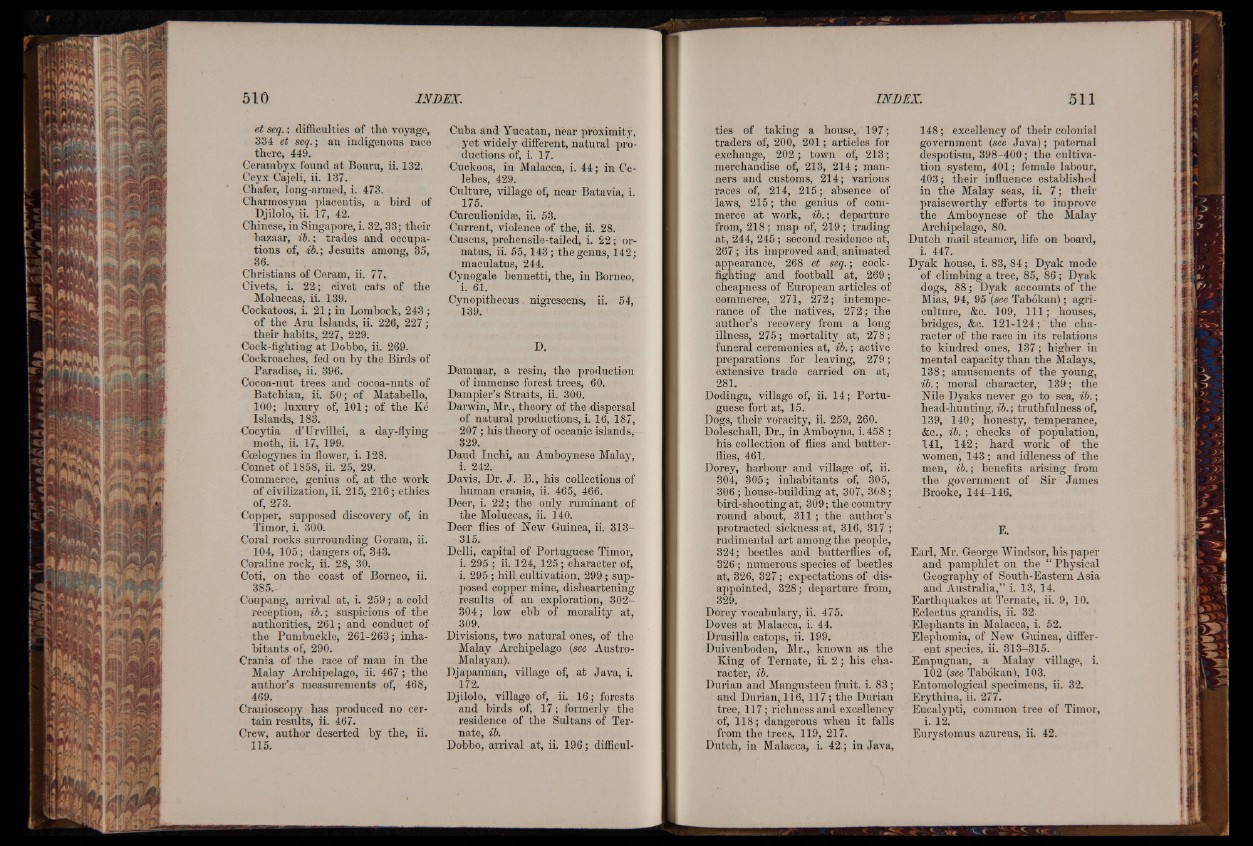
et seq. ; difficulties of the voyage,
334 et seq.; an indigenous race
there, 449,
Cerambyx found at Bouru, ii. 132.
Ceyx Cajeli, ii. 137.
Chafer, long-armed, i. 473.
Charmosyna plaeentis, a bird of
Djilolo, ii. 17, 42.
Chinese, in Singapore, i. 32,33; their
bazaar, ib. ; trades and occupations
of, ib.; Jesuits among, 35,
36.
Christians of Ceram, ii. 77,
Civets, i. 22; civet cats of the
Moluccas, ii. 139.
Cockatoos, i. 21; in Lombock, 243 ;
of the Aru Islands, ii. 226, 227;
their habits, 227, 229.
Cock-fighting at Dobbo, ii. 269.
Cockroaches, fed on by the Birds of
Paradise, ii.. 396.
Cocoa-nut trees and cocoa-nuts of
Batehian, ii. 50; of Matabello,
100; luxury of, 101; of the Ke
Islands, 183.
Cocytia d’Urvillei, a day-flying
moth, ii. 17, 199.
Ccelogynes in flower, i. 128.
Comet of 1858, ii. 25, 29.
Commerce, genius of, at the work
of civilization, ii. 215, 216; ethics
of, 273.
Copper, supposed discovery of, in
Timor, i. 300.
Coral rocks surrounding Goram, ii.
104, 105; dangers of, 343.
Coraline rock, ii. 28, 30.
Coti, on the coast of Borneo, ii.
385-
Coupang, arrival at, i. 259; a cold
reception, ib.; suspicions of the
authorities, 261; and conduct of
the Pumbuekle, 261-263; inhabitants
of, 290.
Crania of the race of man in the
Malay Archipelago, ii. 467; the
author’s measurements of, 468,
469.
Cranioscopy has produced no certain
results, ii. 467.
Crew, author deserted by the, ii.
115.
Cuba and Yucatan, near proximity,
. yet widely different, natural productions
of, i. 17.
Cuckoos, in Malacca, i. 44; in Celebes,
429.
Culture, village of, near Batavia, i.
175.
Curculionidæ, ii. 53.
Current, violence of the, ii. 28.
Cuscus, prehensile-tailed, i. 22 ; or-
natus, ii. 55,143; the genus, 142;
maculatus, 244.
Cynogale bennetti, the, in Borneo,
i. 61.
Cynopithecus. nigrescens, ii. 54,
139.
D.
Dammar, a resin, the production
of immense forest trees, 60.
Dampier’s Straits, ii. 300.
Darwin, Mr., theory of the dispersal
of natural productions, i. 16, 187,
207; his theory of oceanic islands,
329.
Daud Inchi, an Amboynese Malay,
i. 242.
Davis, Dr. J. B., his collections of
human crania, ii. 465, 466.
Deer, i. 22; the only ruminant of
the Moluccas, ii. 140.
Deer flies of Hew Guinea, ii. 313-
315.
Delli, capital of Portuguese Timor,
i. 295 ; ii. 124, 125; character of,
i. 295 ; hill cultivation. 299; supposed
copper mine, disheartening
results of an exploration, 302-
304; low ebb of morality at,
309.
Divisions, two natural ones, of the
Malay Archipelago (see Austro-
Malayan).
Djapannan, village of, at Java, i.
172.
Djilolo, village of, ii. 16; forests
and birds of, 17; formerly the
residence of the Sultans of Ter-
nate, ib.
Dobbo, arrival at, ii. 196; difficulties
of taking a house, 197;
traders of, 200, 201; articles for
exchange, 202; town of, 213;
merchandise of, 213, 214; manners
and customs, 214; various
races of, 214, 215; absence of
laws, 215; the genius of commerce
at work, ib. ; departure
from, 218; map of, 219; trading
at, 244, 245; second residence at,
267; its improved and, animated
appearance, 268 et seq.; cock-
fighting and football at, 269;
cheapness of European articles of
commerce, 271, 272; intemperance
of the natives, 272 ; the
author’s recovery from a long
illness, 275; mortality at, 278;
funeral ceremonies at, ib.; active
preparations for leaving, 279;
extensive trade carried on at,
281.
Dodinga, village of, ii. 14; Portuguese
fort at, 15.
Dogs, their voracity, ii. 259, 260.
Doleschall, Dr., in Amboyna, i. 458 ;
his collection of flies and butterflies,
461.
Dorey, harbour and village of, ii.
304, 305; inhabitants of, 305,
306 ; house-building at, 307, 308;
bird-shooting at, 309; the country
round about, 311 ; the author’s
protracted sickness at, 316, 317 ;
rudimental art among the people,
324; beetles and butterflies of,
326 ; numerous species of beetles
at, 326, 327; expectations of disappointed,
328; departure from,
329.
Dorey vocabulary, ii. 475.
Doves at Malacca, i. 44.
Drusilla catops, ii. 199.
Duivenboden, Mr., known as the
King of Ternate, ii. 2; his character,
ib.
Durian and Mangusteen fruit, i. 83 ;
and Durian, 116,117; the Durian
tree, 117; richness and excellency
of, 118; dangerous when it falls
from the tree?, 119, 217.
Dutch, in Malacca, i. 42; in Java,
148; excellency of their colonial
government (see Java); paternal
despotism, 398-400; the cultivation
system, 401; female labour,
403; their influence established
in the Malay seas, ii. 7; their
praiseworthy efforts to improve
the Amboynese of the Malay
Archipelago, 80.
Dutch mail steamer, life on board,
i. 447.
Dyak house, i. 83, 84; Dyak mode
of climbing a tree, 85, 86; Dyak
dogs, 88; Dyak accounts of the
Mias, 94, 95 (see Tabokan); agriculture,
&c. 109, 111; houses,
bridges, &e. 121-124; the character
of the race in its relations
to kindred ones, 137; higher in
mental capacity than the Malays,
138; amusements of the young,
ib.; moral character, 139; the
Nile Dyaks never go to sea, ib. ;
head-hunting, ib.; truthfulness of,
139, 140; honesty, temperance,
&e., ib. ; checks of population,
141, 142; hard work of the
women,"143 ; and idleness of the
men, ib.; benefits arising from
the government of Sir James
Brooke, 144-146.
E.
Earl, Mr. George Windsor, his paper
and pamphlet on the “ Physical
Geography of South-Eastern Asia
and Australia,” i. 13, 14.
Earthquakes at Ternate, ii. 9, 10.
Eclectus grandis, ii. 32
•Elephants in Malacca, i. 52.
Elephomia, of New Guinea, different
species, ii. 313-315.
Empugnan, a Malay village, i.
102 (see Tabokan), 103.
Entomological specimens, ii. 32.
Erythina, ii. 277.
Eucalypti, common tree of Timor,
i. 12.
Eurystomus azureus, ii. 42.